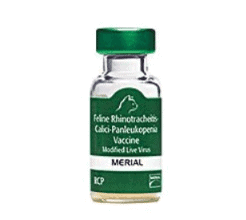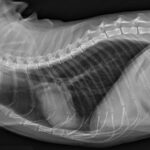Symptoms
- Sneezing
- Nasal discharge
- Runny eyes
- Cough
- Oral or nasal ulcers
- Sniffles
- Fever
- Hoarse voice
- Or any combination thereof
The agents of feline upper respiratory infection are contagious and occur most frequently when cats live in groups. Getting infected is easy; a cat just simply shares the environment with an infected cat – just like people picking up a common cold.
The average indoor house cat is lower risk for infection; however, it is important to realize how common upper respiratory infection is. And even indoor only cats can have latent herpesviruses that show up when the cat is under stress.
In some shelters or catteries, the infection rate may be as high as 60 percent. This means that there is a good chance that any cat or kitten is already infected at the time of adoption regardless of whether the cat is showing any symptoms.
Kittens are predisposed due to their immature immune systems, and are usually hit the hardest. When these kittens grow up, they are still infected and symptoms may come out whenever stress suppresses their immune system.
Typically, infected cats come from the shelter, are outdoor cats, or are housed in close contact with lots of other cats (experiencing crowding stress). Persian cats are predisposed to upper respiratory infection due to their genetic facial flattening.
The chief infectious agents that cause feline upper respiratory infections are herpesvirus and calicivirus, together accounting for about 90 percent of infections. Other agents include: Chlamydophila, Mycoplasma, Bordetella, and others. Of course, a cat or kitten may be infected with more than one agent.
Viruses are spread by the wet sneezes of infected or carrier individuals. The herpesvirus is fragile, surviving only 18 hours outside its host; calicivirus is tougher, lasting up to 30 days. Bleach will readily inactivate either virus but calicivirus can survive unbleached laundry detergents.
Infection Course
To some extent, the combinations of symptoms and course of infection is determined by which of numerous infectious agents is responsible.
Ninety percent of feline upper respiratory infections are caused by either feline herpes (also called the rhinotracheitis virus) or feline calicivirus. Neither of these infections is transmissible to humans or to other animals.
Just as in people, most feline colds run a course of 7 to10 days regardless of treatment although sometimes antibiotics are employed to prevent secondary bacterial infections. It is important to realize that these infections are permanent and that herpesvirus infections are recurring (a property of all types of herpes infections).
In kittens, herpes infections are notorious for dragging out. Stresses such as surgery (usually neutering/spaying), boarding, or introduction of a new feline companion commonly induce a fresh herpes upper respiratory episode about a week following the stressful event and the active virus sheds for another couple of weeks.
A cat with herpes is contagious to other cats for a couple of weeks after a stressful event. Cats infected with calicivirus are contagious for several months after infection but do not appear to have recurrences the same way cats with herpes do.
When to be Concerned: Signs a Cat Requires Hospitalization
The next most common infectious agents (after herpes and calici) are Chlamydophila felis (formerly known as Chlamydia psittaci) and Bordetella bronchiseptica, both organisms being sensitive to the tetracycline family, such as doxycycline.
- Loss of appetite
- Congestion with open mouth breathing
- High fever (or the extreme listlessness that implies a high fever if you cannot take the cat’s temperature).
A cold for a cat is usually just a nuisance like a cold usually is for one of us. Sometimes, though, an upper respiratory infection can be serious. If a cat is sick enough to stop eating or drinking, hospitalization may be needed to get through the brunt of the infection.
A cat (usually a kitten) can actually get dehydrated from the fluid lost in nasal discharge. Painful ulcers can form on the eyes, nose or in the mouth, especially if calicivirus is involved.
Sometimes fever is high enough to warrant monitoring. In young kittens, pneumonia may result from what started as an upper respiratory infection.
If you think your cat or kitten is significantly uncomfortable with a cold and/or not eating, you should seek veterinary assistance.
How is this Usually Treated?
How an upper respiratory infection is treated depends on how severe it is and whether or not there seems to be a bacterial infection complicating the viral infection.
A mildly symptomatic adult cat might need no treatment at all as the symptoms should naturally wane over one to two weeks. A heavily congested kitten is likely to need antibiotics, antivirals, fluids and possibly even hospitalization.
A Note on Antibiotics
Antibiotics act not only on bacteria that complicate viral infections but some upper respiratory infections are bacterial and not viral at all.
The next most common infectious agents (after herpes and calici) are Chlamydophila felis (formerly known as Chlamydia psittaci) and Bordetella bronchiseptica, both organisms being sensitive to the tetracycline family (such as doxycycline).
For this reason, when antibiotics are selected, tetracyclines and their relatives are frequently chosen. Other commonly used antibiotics are: Clavamox®, azithromycin and clindamycin. Oral medications, and/or eye ointments are commonly prescribed.
Severely affected cats may need to have inhalational antibiotics, fluids administered intravenously or under the skin to maintain hydration, and/or some sort of assisted feeding.
Special Therapies
Some cats are severely affected and addressing the secondary bacterial infection is simply not enough to achieve comfort. For these situations, antiviral medications such as famciclovir (reduces herpesvirus replication) can be used to address the actual viral infection and often even chronic symptoms can be controlled at least temporarily.
Cats are too small to be able to meaningfully blow their noses or sneeze out very dry or thick sinus secretions. Oral supplementation with N-Acetylcysteine can be helpful in breaking down this material or a children’s nasal drop can help reduce congestion.
Polyprenyl immunostimulant is a biological product made by Vetimmune® currently licensed by the USDA to treat feline herpes infection. This product is given orally once a day for 2 weeks and reportedly stimulates cellular immunity (as opposed to antibody-related immunity).
More chronically infected cats with severely blocked sinuses can have their sinuses flushed out under anesthesia. This can clear a great deal of material out of the nasal passages but how long results persist is variable.
Consult your veterinarian before attempting any sort of home treatment.
What are the Vaccination Options?

Vaccination is unlikely to be completely preventive for the upper respiratory viruses and is instead meant to minimize the severity of the symptoms. In selecting a vaccine against upper respiratory infections, there are some choices. The most common is the injectable vaccine called FVRCP referred to as a “three in one” vaccine.
This covers for distemper, herpesvirus, and calicivirus and panluekepenia. This is the vaccination recommended by the American Association of Feline Practitioners in its vaccination guidelines.
There is some feeling that nasal vaccines may provide a more complete stimulation to the area of the immune system responsible for defense against the infection in question. Nasal vaccination provides protection especially rapidly (3 or 4 days). Herpes and calicivirus vaccines can be given either nasally or by injection.


